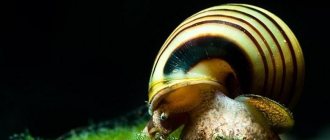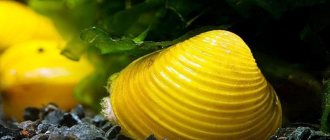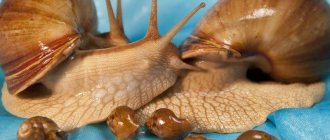Before you add a snail brought from the street into your home, you should weigh everything carefully and decide whether it is worth doing. Mollusks of the middle zone are more demanding in terms of living conditions than captive-bred Achatina or Archatina. In addition, no one can guarantee that a new pet will not be a carrier of infections or parasites. We will tell you what street snails are and how to keep them at home in this article.
What to feed wild animals at home?
In the first days of their lives, small street snails eat the shell of their eggs, which contains all the necessary substances.
However, as adults, individuals change their gastronomic tastes. For example, grape snails love to eat young grape leaves, which is why they got their name. At home, the owner can feed the pet more varied. Favorite foods also include leaves:
- Strawberries;
- Raspberries;
- Dandelion;
- Plantain.
Sometimes they can be found on horseradish, radish, cabbage and some other types of crops. Animals mainly feed on rotten parts, but it can also damage a healthy plant. Adult forest snails also feed on juicy fruits, so they readily eat fruits and berries, in particular strawberries in the spring.
Despite the fact that gastropods are considered herbivores, it has been noted that they can also eat food of animal origin - broken eggs, insect larvae, worms.
At home, forest and garden snails are omnivorous, but it is important that the food is fresh and juicy. Forbidden! Dangerous products!
Forbidden! Dangerous products!
- Salt and chemical fertilizers;
- Bitter, sour, ready-made food for other domestic animals;
- Bread, pasta;
- Beans in any form and raw potatoes.
All other vegetables and fruits are allowed. Separately, you can cook chicken, boiled potatoes and eggs for wild garden snails, the main thing is not to add salt.
Most often, street pets are fed what they eat in the wild. But at home, protein and calcium are added to their diet.
Protein is found in specialized supplements such as daphnia and gammarus, and at home you can prepare simple and tasty snail food.
You should know it! It is not advisable to give snails pork or other meat; for them it is very tough and difficult to digest.
Wild snails need plenty of calcium. In nature, what street snails eat is already rich in calcium, but it should always be given at home. For this purpose, special sepia is used, from the store or feed chalk. You cannot use school chalk, it contains a lot of chemicals.
Important! It is strictly prohibited to use tablets from a pharmacy as calcium, as it is poison for them.
The mineral content is high in shell rock, chicken egg shells and fish bone meal. But all this must be ground in a coffee grinder in advance.
At home, wild street snails are fed once a day, preferably in the evening, as they sleep during the day. But over time, their rhythm may change.
Harm of gastropods to the garden
Don't underestimate the damage caused by snails and slugs.
These pests that visit the garden and vegetable garden damage fruits, vegetables and berries. Not every gardener and summer resident knows how to combat these pests. It should be remembered that the damage caused by gastropods in a summer cottage does not only involve directly eating plants. In addition, snails are able to move between rows of vegetation and carry fungal spores, infecting healthy plants with them.
Damaged fruits become defenseless against the spread of many diseases affecting cultivated plants.
If you do not get rid of such garden pests as the grape snail and its close relative the slug, then they can cause very serious harm, which consists of the following:
The diet of grape snails and slugs includes more than 150 species of plants, so in almost every area there is greenery that attracts gastropods as food.
It is unacceptable to ignore the mass appearance of gastropods in a garden or summer cottage.
House for a snail
Even before purchasing a pet, you should think about where your grape snail will live.
The best option for a snail's home would be an old aquarium or a large transparent box. The snail is a fairly mobile creature, albeit slowly, but the animal is capable of covering relatively long distances. Therefore, when choosing a new home for a snail, you should take a medium or large sized aquarium so that the pet has room to move around. Be sure to cover the aquarium or box with a lid to prevent the snail from escaping.
Remember! The lid must have holes for free air circulation to prevent the pet from suffocating!
Keeping a grape snail requires the presence of soil or special soil in the pet’s home. It is best to use specialized soil, which is sold in pet stores. But if there is no such store nearby, you can also use soil from the garden. Carefully sift the dug up soil and select all kinds of weeds. Then put the soil in the oven for 5-10 minutes at high temperature. This procedure will allow you to destroy parasites, which, without any doubt, live on the soil you have dug up, and can be extremely dangerous for the snail.
The soil in a grape snail aquarium performs two functions:
- allows you to maintain moisture in your pet’s home;
- protects the snail from damage when falling into the walls of the cage or any objects.
The soil in the snail's aquarium should be slightly moistened. Don't overdo it, because... being in damp soil, a snail can get sick.
When breeding grape snails at home in a pet's cage, the presence of soil is a prerequisite. Since the snail lays eggs in the ground.
Read more about keeping snails at home and caring for them here.
Housing for your pet and proper care
A street snail can live in an ordinary aquarium, left over from a fish hobby that has not taken root. If you don't have an aquarium, you can use a terrarium or a large plastic container. Soil is poured onto the bottom; enough of it is needed so that the snail can burrow into it, since it serves as a bed for them. The substrate must be wet, but no water should come out when compressed.
Interesting! The soil in the terrarium plays an important role; during breeding, they make nests in it; the softer it is, the easier it is for them to make a place for laying eggs.
In addition, wild garden and forest snails are considered climbers; they often climb walls, and if they fall, the ground protects them from injury. But sawdust cannot be used, as they can eat it.
Read more about what to use as a terrarium and how to equip it for snails
When using store-bought coconut substrate for street snails, it is pre-soaked in water for several hours. When using land, it is taken from a park or forest. It is important that there are no fertilizers or chemicals in it. Before laying the house, it should be calcined at high temperatures or boiled. You can use ready-made soil for begonias from flower shops.
Instead of purchased soil, you can use sphagnum moss or peat, only neutralized. If the peat has high acidity, the forest snail shell will begin to deteriorate quickly.
Read about other types of soil for snails.
A lid is placed on the container. You can’t live without it, since the snail taken from the street is wild and very inquisitive, especially at home. She can run away and get lost. If it falls, it will break the sink or eat the wallpaper on the walls, which is also not allowed.
You can buy a terrarium, soil and other equipment for caring for forest and street snails on Aliexpress.
Plot size
Snail farms vary in size, depending on who runs them. Hobbyists who grow shellfish in small quantities use an area of 10 to 20 acres. Farmers who engage in this as an alternative to other activities occupy on average from 30 acres to 1 hectare. Large commercial producers usually start with 2 hectares and can use 30 hectares as the business grows. Additional crop areas beyond that allocated to snails are occupied by secondary crops such as sunflowers.
What do grape snails look like and where are they found?
Grape snails are able to adapt to almost any conditions and are generally unpretentious. The reservoirs for their storage are called molluscaria.
Of the conditions created for them, three options are noted:
- in enclosed spaces;
- in an enclosure on farm plots;
- in greenhouses.
In nature, slugs prefer damp places in forests with an abundance of piled wood. They can often be found in hop thickets. Without trying too hard, 20 grape snails can easily be found after drizzling rain under stumps in forest belts.
Another place where they usually are is piles of brushwood, covered with the leaves of a climbing plant (for example, a wild vine). They can also be found on tree trunks.
The humidity level in the intended location of the snails should be in the range of 85 - 90%, and the temperature - 20 - 25°C. Thus, shellfish can be either purchased from a farm or collected yourself.
Breeders usually sell them by weight. In one kilogram you can count about 20 individuals with a shell diameter of 5 cm and a weight of approximately 50 g. This species is considered the largest in Europe.
What are the benefits and harms of snails in the garden?
Snails in the garden are unnoticeable neighbors in the area; these representatives of the animal world are the worst pests.
During the daytime, snails in the garden and snails in the country are practically invisible, since in hot weather these mollusks hide in secluded places. Which are always cool and humid.
The harm caused by snails in the garden is that they can destroy the harvest of cultivated plants. These slow-moving representatives of the animal world are voracious and eat everything from weeds to cultivated plants.
Snails belong to the class of gastropods.
Principles of organizing proper nutrition for African Achatina
There are basic principles of snail nutrition that apply to all species:
- Achatina’s daily diet should include a variety of plants;
- Important animal proteins supplement the snails' main diet;
- The third mandatory component of the diet of Achatina snails is mineral feeding.
The nutrition of African Achatina snails at home is based on these three basic principles. A constant lack of one of the components will lead to illness in the tender snail and its possible death.
The African snail Achatina in its natural habitat prefers leaves and grass, tree bark and juicy tropical fruits. It seems that Achatina are real gourmets, they can eat fresh herbs and immediately snack on half-rotten berries. Certain species of Achatina consider fallen rotting wood a real delicacy and can eat it entirely in a huge colony without leaving a trace. As you know, snails have many teeth, they are quite voracious, often attack large plantations of cultivated plants and in a short time cause irreparable damage to farming.
Under no circumstances should cut up newspapers be placed in the aquarium of domestic snails as bedding. Eating paper, especially with printed font, will lead to the death of pets. And, most importantly, the tender Achatina is very afraid of grains of salt. They corrode their thin skin and burn their insides. Half a teaspoon of salt can kill an entire herd of defenseless snails!
It is not advisable to include citrus fruits and other sour fruits in the daily diet of Achatina snails. Any strong acids negatively affect the digestion and vital functions of Achatina. These foods are not strictly prohibited; they can be given in limited quantities and the reaction and condition of the snails can be monitored.
Conditions of detention
Street snails require a vertical terrarium with a volume of 4 liters per mollusk. The terrarium should have a lid and holes for moderate ventilation. When necessary, use gauze instead of a lid. This will help avoid sudden changes in humidity inside and outside the container.
The use of coconut backing and mats for outdoor snails is not advisable. Such materials are not natural for natural mollusks and can cause serious stress to them.
The type of moss for bedding does not matter much. You can use carpet moss or sphagnum. Leaf litter can also be taken from almost any tree. These can be leaves of oak, birch, or any fruit tree.
It is desirable that street snails have the opportunity to hide in a shelter. In their natural environment, mollusks always try to climb into hard-to-reach places or burrow into the ground. It’s a good idea to equip a home terrarium with twigs or driftwood to create conditions as close to natural as possible.
Avoid exposing the snail to direct sunlight. She must have at least one reliable shelter where the mollusk can hide from bright light.
Breeding grape snails as a business. Assessing business profitability
Before you start growing snails for restaurants, you need to analyze how high the demand for your products will be. It must be said that these shellfish are in demand not only in the food industry. Today you can make good money by selling goods in bulk for the preparation of cosmetic and medical preparations. It is especially advisable for such purposes to breed Achatina snails. As a business, such a project will fully recoup the investment, which, by the way, will be slightly higher than if you plan to engage in grape snails, which are familiar to our latitudes.
Today, creating your own snail farm will become a very profitable enterprise - after all, in our country this market niche is still empty, but there is a demand for the products
By the way, this variety is also successfully used by pharmacists and cosmetologists, not to mention the nutritional value of their meat. This delicacy is sure to be included in the menu of the best restaurants of both European and Asian cuisine. In addition, even supermarkets can sell similar goods. In a word, you should find a sales market without much difficulty.
Breeding snails at home as a business is also beneficial due to its versatility. You can start growing shellfish both on your personal plot and in an ordinary room in a city home. Moreover, by creating favorable conditions for animals to reproduce and develop, you will not feel any difference in the timing of receiving the finished product.
Usually a snail matures in eighteen months, but here the time boundaries are quite blurred, they range from six months to three years. Experts recommend purchasing mature individuals in order to slightly reduce the time it takes to receive your first profit. The hermaphroditism of animals will also be a very significant advantage. After all, in such a situation you can get a litter from each of the pets you purchased. In a word, growing snails as a business is a promising and profitable project, especially considering that this niche in the CIS market is still empty.
Public catering facilities
Of course, restaurants are more interested in purchasing domestic raw materials for preparing seafood dishes. Today, in the coastal waters of the Sea of Okhotsk, the Sea of Japan and the Black Sea, there are farms where mussels are grown on an industrial scale. But you have to buy snails. Therefore, elite cafes and restaurants are interested in the development of domestic helicopter culture.
Shellfish meat is a delicacy that is distinguished by a whole range of beneficial properties and qualities. So, it contains magnesium, iron, calcium, phosphorus, zinc, copper and a large amount of vitamins (PP, K, A, E). Shellfish are indicated for pregnant and lactating women, as they are a natural source of calcium, and for babies. Snails are lean meat that contains a large amount of protein. By the way, for the same reason, snails are popular among bodybuilders and athletes.
Snails are cooked very tasty in France and Italy. But domestic culinary gurus have also learned to use dietary meat wisely.
https://youtube.com/watch?v=8-LY4Gxb904
Snail farm business plan. Selection of site and soil structure
A snail farm is organized in open pastures with suitable plants grown on them that serve as food and shelter for the mollusks. No covering is used to create shade. When choosing a location for a snail farm, the prevailing wind direction is taken into account, since strong winds dry out the soil.
Soil analysis and disinfection is carried out to ensure suitable conditions for growing leafy green vegetable crops and eliminating carnivorous insects and pests. Loose soil with an acidity of 5.8–7.5 pH is recommended.
Soil that is too acidic is not suitable for snail production. it should contain about 3-4% calcium. The soil structure is medium to light.
Clay soil is unsuitable for egg laying as it is too difficult for snails to dig through and easily becomes waterlogged.
It is important that plants and shellfish are kept moist by dew, rain or controlled mist. The snail (photo shown in the article) moves more easily when the leaves and ground are wet
They eat more and grow faster under the right environmental conditions.
Rain and controlled irrigation are essential for snail production.
Good soil drainage is necessary to prevent water from pooling on the ground.
The breeding site should be free of large trees, as they attract birds of prey, shade the plants and prevent the formation of dew.
Where to buy grape snails for breeding? Farmers purchasing shellfish from snail harvesters or the market should expect high mortality rates as a result of poor adaptation to other foods.
The most reliable source of breeding material is well-known producers or agricultural institutes.
Such a grape snail (its price will be higher) is better and safer, since it received proper nutrition from birth and was not damaged during collection and storage.
The use of preventive measures in the garden and summer cottage
It is quite difficult to combat the invasion of gastropods, so it is easier to use preventive measures that can prevent the appearance of these pests in the garden plot or vegetable garden.
First of all, you should provide an environment in the garden that is unfavorable for the existence of these living creatures.
For this purpose, all excess stones and building materials that could create conditions acceptable for gastropods should be removed from the site.
The land should be cultivated in a timely manner to control weeds. It is advisable to mow excess grass in a timely manner.
In order to prevent mollusks from hiding in cracks, the soil should be loosened as often as possible, especially during the period of active vegetative growth of plants. After harvesting, you should thoroughly clean the garden, getting rid of all plant debris.
Site preparation
The area is cleared of grass and weeds by using a contact herbicide. The soil is then cultivated using a rotary cultivator and a fence is erected around the perimeter. Fertilizers are introduced into the soil, and chemical disinfestation from insects and animals is carried out. The area is then divided into sections for the first year's production and wooden posts are installed to support the internal fencing.
The soil is again prepared by subsequent rotary loosening and, if required, the addition of lime, and irrigation is installed. Sowing is carried out after the surface has been leveled and internal fences have been erected. Finally, to make maintenance easier, the paths are treated again with a contact herbicide.
Description of the grape snail
The grape snail is a type of land snail and is one of the largest. Its natural habitat is Central and South-Eastern Europe, from where it was brought to South America. This terrestrial gastropod belongs to the order stalked, it has an asymmetrical body, a clearly visible head and a flat, wide leg. The grape snail has 2 pairs of tentacles and 1 pair of eyes on its head. The shell of the mollusk is curved in the form of a spiral, and forms 4-5 turns. Snails breathe with their lungs, so they cannot live in water. As a rule, the color of the mollusk is uniform, yellowish-orange. The height of the shell reaches 45 millimeters, and the width is 46-47 millimeters, but the weight is from 22 to 45 grams (it all depends on how and what you feed your grape snail).
Where do grape snails live in Nature?
If you want to create comfortable conditions for your unusual pet in your home, it won’t hurt you to know where grape snails live in Nature. So, their habitats are valleys and mountains, the edges of deciduous forests, parks, meadows, ravines overgrown with bushes, vineyards, and alkaline soils. In dry weather, these moisture-loving creatures hide under stones, in the shade of plants, or bury themselves in moss. If there are abnormally high temperatures outside, then they become lethargic and may even fall into a state of torpor - something akin to hibernation, but as soon as the rains begin, the snail gets out of the shell and becomes active again. So, you will have to try to create similar comfortable conditions for her at home.
Not only a high temperature, but also a decrease in temperature can plunge a snail into a state of torpor. So, at a temperature of 9-12 degrees above zero Celsius, it can already hibernate, and snails can hibernate either individually or in entire snail colonies, burrowing into the soil to a depth of 5-10 centimeters.
In the spring, as soon as it gets a little warmer outside, the snails wake up. By the way, according to experts, grape snails are able to tolerate lower temperatures - they can live for several hours even at temperatures of -7 degrees below zero.
Considering the peculiarities of the comfortable temperature regime for these mollusks, it is not surprising that grape snails spend most of their lives in a state of hibernation and torpor, and are awake only 4-5 months a year.
What do grape snails eat in Nature?
Similar to the previous point, we invite you to familiarize yourself with the diet of grape snails in free-living conditions. This information will become a kind of guide for you, which will help you find out what you should include in your shellfish menu, and what it is better to refuse. So,
Grape snails are primarily herbivorous creatures; they eat green grass, leaves and can feed on humus.
Nutrition
At its core, the grape snail is a vegetarian. What is the best way to feed a grape snail at home?
The basis of the diet is:
- whole and chopped berries, fruits;
- herbal, vegetable or fruit humus;
- vegetable ovary;
- fallen leaves;
- stems of sorrel, burdock, horseradish, plantain, leaves of flower stalks.
At the same time, the pet is gluttonous. Therefore, she will not be satisfied with vegetables and fruits alone; vegetable protein is preferable in her diet.
To grow and strengthen the shell, you will need to provide your pet with calcium. Its sources may be different:
- chalk;
- eggshell;
- cuttlefish shell - sepia.
You will also need protein supplements such as bloodworms and daphnia.
Everything that the mollusk has not eaten must be thrown away so that flies do not appear in the food, and the food itself does not rot.
Calculation of costs and profitability
Costs and profitability are different for everyone who breeds snails.
It depends on some factors:
- Buying broodstock or raising it yourself.
- Forming pens with your own hands or buying ready-made ones.
- Use of special equipment (to maintain temperature, humidity and light).
You can raise the broodstock yourself (this applies to grape snails) depending on where you live. They can be found in Australia, Southern Russia and countries with temperate climates. You can buy a ready-made one, its price is about $200 for 50 pieces. To create a full-fledged snail farm, you will need 750 snails, the cost of which will be $3,000.
To maintain one snail you need about 2 rubles a month, that is, for 750 you need 1500 rubles. To purchase equipment (pens, ditches, boxes) you need about $500.
Hence the conclusion is drawn that to fully start a business you need to have $3,500 for snails and 1,500 rubles per month for their maintenance. Sales of one ton of snails will cost approximately $10,000. All costs will be recouped by 150% in eight months.
If the broodstock is formed independently, you can save about $3,000.
If all the rules are followed, the snail business can become quite profitable for those who want to open their own business, spending a minimum of effort and receiving maximum profit.
Grape snail and man
Breeding
Grape snails have been bred since ancient times. According to Pliny the Elder, Fulvius Lippinus was the first to breed them.
Now in a number of countries there are so-called “snail farms”, where grape snails are bred in large quantities for subsequent preparation or export, creating favorable conditions for them.
Many people keep representatives of the species along with Achatina as pets.
Application
Escargot from grape snails
In cooking
Grape snail meat contains 10% protein, 30% fat, 5% carbohydrates, as well as vitamins B6, B12, iron, calcium, magnesium. According to the Institute of Fisheries of the National Academy of Sciences of Belarus, the air-dry matter of grape snail meat contains 60-65% protein, about 5% fat, the rest is low-molecular organics and mineral compounds - ash. [ source not specified 2636 days
] In Spain, France and Italy, the grape snail is eaten. In France, it is cooked in the shell in vegetable oil, seasoned with parsley (see escargot). It is believed that its taste is superior to that of other edible snails. In France, Germany, Austria, Switzerland and a number of other countries it is rare and protected by law; imported from Greece and other countries where it is collected or specially bred (heliceculture). In a number of countries, including Russia in the Kaliningrad region, snails are widely bred for sale to restaurants, for the pharmaceutical industry, and for sale in stores.
In 2010, culinary specialist Dominique Pieru found a way to salt snail eggs and prepare so-called snail caviar
. This dish tastes like noble types of mushrooms.
Image in culture
Coat of arms of the municipality of Zell
In heraldry
The grape snail is depicted on the coat of arms of the Swiss municipality of Zell (Zurich). The symbolic meaning is unclear. It is known that the image first appeared in 1845 on the lantern of the village fire service (possibly as a distinctive sign for the high responsiveness of the service). The commune then adopted the coat of arms in 1930.
In art
In the song “Snail”, the lyrics for which were written by Alexander Kushner and performed by Sergei Baltser, there are the lines:
| You enter the garden through a rusty gate, What is this dead soil in the cracks? The God of the grape created a snail, So that we could conduct experiments on it. |
The grape snail is an enemy of agriculture. Primarily because it feeds on young shoots of agricultural crops, in particular grapes. In a number of countries it is the subject of extermination. In some countries, in particular the countries of North and South America, the import of grape snails is prohibited.
Care of offspring
Growing grape snails is not difficult. Adults lay white eggs underground, in a previously prepared place. After this, 3-4 weeks pass before the offspring hatch. A newborn snail first eats the shell of the egg from which it emerged, and then heads upward. After about ten days, the snail climbs out. All this time they feed on useful substances that are in the soil. At this time, it is necessary for her shell to become stronger so that she can hide in it in times of danger. Babies are fed finely grated fruits and vegetables to help them grow faster. It is also necessary to give mineral supplements.
Arrangement of the terrarium
How to care for garden snails in captivity? First of all, they need soil to hide in if necessary. The humidity of the substrate should be such that no water comes out when pressing on it.
It is better to use soil from the place where the snail was taken. The layer of soil not treated with pesticides should be sufficient for the mollusk to burrow completely into it.
Flower soil is not suitable for creating a terrarium substrate. It contains chemical additives that are harmful to shellfish.
Sphagnum moss, vermiculite, compost or peat work well as a soil covering. They absorb and retain moisture well, which prevents the substrate from drying out. Such conditions for keeping garden snails are as close to natural as possible, which contributes to their normal life.
An untreated snag or branch placed in a terrarium will greatly help a garden snail feel “at home.” The mollusk will always be able to find shelter under it if it senses danger. He also likes to hide in damp fallen leaves and spends most of his time in such a “shelter”.
Description of the grape snail
The body of the grape snail, along with other representatives of the Gastropod class, is externally divided into parts such as a shell and a body, consisting of a leg and a head. The internal organs of the snail are surrounded by a special protective mantle, some of which is quite clearly visible even from the outside.
Appearance
The shell of an adult has an average diameter of 3.0-4.5 cm, and its volume is quite sufficient to fully accommodate the body. The shell is distinguished by a spiral curve of 4.5 turns. Shell coloration can vary from light tan to attractive brownish-white shades.
Along the entire length of the first two or three whorls there are five dark and the same number of light stripes. The saturation of color directly depends on the soil and climatic conditions in the habitat, the characteristics of the diet and the intensity of lighting.
As a rule, the total length of the leg of a fully adult individual does not exceed 3.5-5.0 cm, but such a mollusk can easily stretch up to 8-9 cm. The body of a grape snail is characterized by increased elasticity, and the color can vary from beige with a brownish tint to a dark gray color.
The surface of the body is covered with numerous wrinkles, the areas between which have the appearance of quadrangles. This feature allows the mollusk to retain moisture very effectively.
A pair of tentacles is located above the mouth opening, and their length may vary. The size of the labial or olfactory tentacles is 2.5-4.5 mm, and the eye ones do not exceed 10-20 mm. Vision allows the snail to clearly distinguish the intensity of light, as well as see objects located at a distance of no more than 10 mm.
Along with other numerous representatives of the Gastropod class, the grape snail has a digestive system represented by an ectodermal foregut and an endodermal midgut. The type of respiration of the above-ground mollusk is pulmonary. The heart is located above the hindgut, and includes the left atrium, ventricle and pericardium. Snail blood has no color. The reproductive system of the grape snail is hermaphroditic, therefore, to produce offspring, the mollusk undergoes cross-fertilization.
Lifestyle and character
During the warm summer period, during the daytime, grape snails try to hide in a shady and damp corner of the garden or forest, and often hide in various cracks or holes. When night falls, the snail leaves its shelter and goes in search of food.
Snails that live in central Europe go into natural hibernation a couple of times a year in winter and summer. Hibernation is similar to the torpor into which a land mollusk enters when it climbs inside its shell. In too cold or hot periods, the grape snail remains inside its shell, and the abundantly secreted mucus serves as a fairly dense protective film for the mollusk.
Lifespan
Grape snails are not among the long-lived pets. As a rule, under conditions of proper care, the average life expectancy of such a domestic mollusk is no more than eight years. However, record life expectancy was recorded in Sweden. In this country, the grape snail has gained fame because it lived for just over three decades.
Reproduction
Cepei Nemoralisa are hermaphrodites. Their sexual maturity occurs when they reach their maximum shell size. The mating process occurs in the spring due to mutual stimulation of the partners. As a result of stimulation, “love arrows” are formed.
Gastropods are capable of storing sperm obtained from a partner for a certain period of time. As a result, some of their litters have mixed parentage.
Between June and August, both partners lay clutches that can contain 20–40 eggs. They are white in color, elliptical in shape and size 2.3 - 2.6 mm by 2.8 - 3.1 mm. The total number of offspring of one individual can reach 80 per year.
Feeding grape snails
Often, the owners of a new snail farm, tempted by the low price, buy food from unscrupulous farming contractors. The breeding conditions will depend on the quality of the feed, so it is better not to skimp on food and know a good manufacturer.
Grape snails are considered pests in many countries; for all the obvious reasons from the name itself, they eat young shoots of grapes. In our homeland, you need to buy such a snail, but it feeds on greens, fruits, and vegetables. The main natural food is chalk. It contains a lot of calcium, which in turn is simply necessary for the construction of the shell. Sometimes protein supplements are necessary. Often used is daphnia, a bloodworm that is sold in pet stores and is more of a fish feeder. There are also restrictions on some products, so be careful. Here is a list of prohibited foods: citrus fruits, radishes, radishes, sorrel, eggs (in any form), onions, cheese, cottage cheese, flour products. Stale uneaten food should be changed as often as possible and prevented from rotting.
How to equip a farm?
Breeding snails in an apartment (even a very large one) will not work. Animals need air. Most often, a separate area is allocated for a snail farm. Definitely surrounded by a thick fence! Otherwise, all its inhabitants will scatter to their own affairs. Fifty square meters will be enough to start with. The plot can be equipped as a regular garden. But don't count on the natural vegetation in the area being enough to feed a herd of snails - the grass will disappear in no time.
It is important to create safe conditions for mollusks, protecting them from attacks by other animals. An ordinary scarecrow is unlikely to scare away birds
For these purposes it is better to use a tarpaulin. One important point is that some beetles feed on snails. It is very difficult to get rid of them, since the poison can also harm shellfish.
Walking
Snails do not need to go for walks like other pets, but fresh air has a very good effect on them - the gastropods' appetite improves and their activity increases. They are taken outside on a cold day in a container. A very short walk is enough for them - only about half an hour. At this time, it is necessary to carefully ensure that the snail’s skin does not dry out; for this, it is recommended to spray it with water from time to time. Keep container away from direct sunlight.
There is no need to let your pets on the grass - sushi snails can attract predators and also catch parasites. These are very fragile creatures that are difficult to treat because it is very difficult to find a veterinarian for such a pet. In any case, you do not need to risk your health and life.
Grape snail - interesting facts
This type of mollusk is one of the most ancient inhabitants of the planet. Scientists are sure that they lived almost 600 million years ago. During this time, a lot of interesting information about them has been collected.
- A snail can crawl across a knife blade without getting hurt. The sole of her foot rests on a “cushion” of mucus.
- Those who are interested in how long a grape snail lives will be surprised by the figure of 30 years. Sometimes there are instances of centenarians with a total duration of 7 years.
- Under unfavorable conditions, mollusks go into hibernation, which can last about six months. In this state, they can tolerate large temperature changes.
- The grape snail is the largest land snail in Europe.
- The grape snail has 25 thousand teeth.
- Salt and sugar are tantamount to poison for them.
Hibernation
The winter diapause period of these snails lasts from December to January. In this case, you should maintain minimal humidity in the terrarium with rare spraying. Room temperature is acceptable. But the cooler it is in the ulitaria, the more comfortable the mollusks will be. Temperature reduction is possible up to +5C.
In summer, regular diapauses are required at intervals of 1–3 times a month. In this case, the mollusk can go into hibernation for 3–15 days. Spraying the terrarium during this period is not required. It is enough to organize good ventilation in the urinal, due to which the humidity level will naturally decrease.











